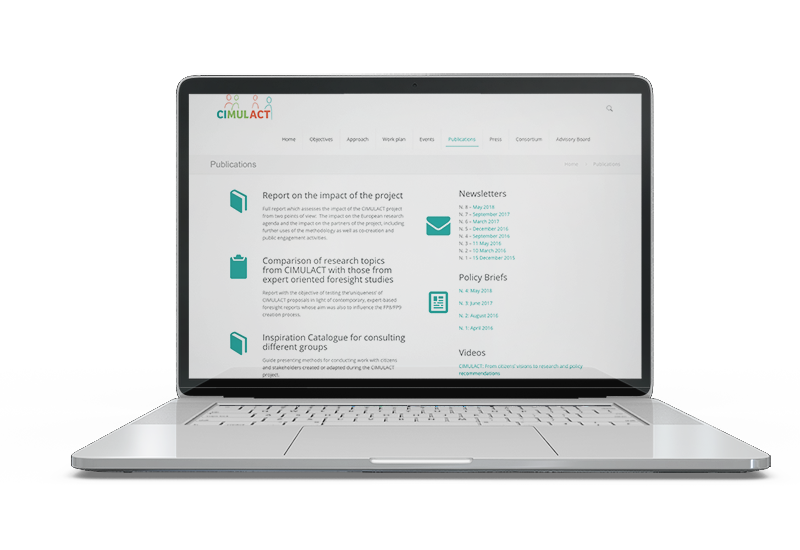CONTEXT AND GOALS
Our society is changing rapidly and we need to find new formulas and adapt to daily realities. To tackle these challenges, the European Union decided to change approach and call on innovation and creativity, especially for its STI (Science, Technology, and Innovation) and RI (Research and Innovation) agendas. This research needs to come up with a solution that combines scientific rigor and civil duty. The CIMULACT project is consistent with this trend as it aims to foster dialogue between citizens, scientists, grassroots stakeholders, and politicians, with the goal of putting forward solutions for a more desirable and sustainable future. The project is based on the idea of society’s collective intelligence and aims to increase the relevance of the European science and technology system from the citizens’ viewpoint.
Lars Klüver
Cimulact project coordinator
PROCEDURE
November-December 2015: an initial phase of 30 national citizens’ consultations from which 180 citizen visions on desired futures emerged. The consultations applied the same method in all 30 countries to enable direct, comparative analysis of the results.
February 2016: A one-day workshop with “challengers” (scientists, artists, journalists, foresight experts, etc.) to identify the underlying social needs expressed in the citizens’ visions.
April 2016: Two days of meetings between citizens and European experts to co-design research scenarios.
September 2016: a second phase of 30 national consultations open to citizens, scientists, stakeholders, policy-makers and the like, to consolidate the research scenarios. This consultation took place both in person and online to gather the views of the largest sample of people possible.
December 2016: A high-level pan-European conference to finalize the research scenarios to be presented to the European Commission.
2017: discussions between all the partners to capitalize on the lessons learned from all the methods developed and deployed for CIMULACT.
2018: sharing all results, analysis of impacts and comparison of all the research programs recommended under CIMULACT, with reports produced by experts.
OUR ADDED VALUE
- Providing concrete and innovative citizen input for future research agendas.
- Involving citizens in the creation and design of research and innovation policies.
- Making European research relevant to the desires of citizens and stakeholders by getting them involved in the co-creation of research and innovation agendas. These agendas are then based on common visions, demands and real needs. Involving policy-makers in this process makes the results even more relevant.
- Contributing to the development of responsible research and innovation in the European Union through the stronger involvement and engagement of citizens to design and identify desirable and sustainable futures.
- Creating new standards for citizen participation by developing, testing and evaluating new methods to facilitate the engagement of citizens and stakeholders.
- Making the construction of tomorrow’s world accessible to the greatest number of people. It is no longer just a matter for experts and policy-makers. This kind of method acknowledges that the debate is broader and allows for greater democracy.
One of the objectives of CIMULACT was to experiment with methods to co-design research and innovation policies and agendas. The CIMULACT approach mixes new methods with others that have already been tried and tested, and can be described as follows:
- Diversity: One of the stated aims of CIMULACT was to experiment with different ways of getting citizens involved when shaping research and innovation policies and agendas. During the CIMULACT project, 11 participatory methods were thus developed and tested.
- Originality: Many of the participatory methods used during CIMULACT are inspired by conventional citizen participation methods. However, CIMULACT has also sparked some new methods that can be used in areas other than research and innovation.
- Quality: The CIMULACT method has set new standards for citizen participation processes with the use of strict criteria for participant recruitment and group facilitation.
- Legitimacy: CIMULACT pools and compares knowledge from different sectors and involves a high number of citizens intended to represent a broad array of social groups.
- Capacity: CIMULACT has contributed to capacity building in a framework designed to make the governance of research and innovation policies more dynamic and accountable.
- Dissemination: all the results have been published and sometimes addressed to target groups in scientific, political or professional spheres.
OUTCOMES
The CIMULACT project has proven that citizens’ vision, expectations and concerns can be easily collected and transformed into political or scientific recommendations and proposals. The political and scientific spheres should not be excluded or exclude citizens, who should be able to enter into a dialogue with these stakeholders. Informed citizens are capable of proposing concrete and original solutions, at national and European levels.
The results have been widely disseminated to the various national and international actors to involve them in this innovative approach and provide inspiration. The approach has also opened new avenues for citizen engagement on a European scale, bolstering responsible research and innovation in the European Union.
KEY FIGURES
DELIVERABLES


Dossier designed and coordinated by members of the Particip-Arc network, with a feature on CIMULACT by Erwan Dagorne from Missions Publiques in favor of CIMULACT (p. 20).



